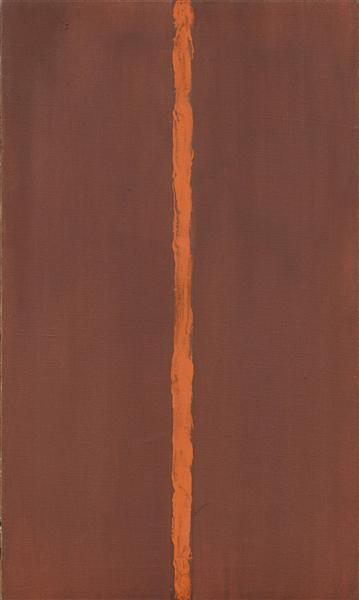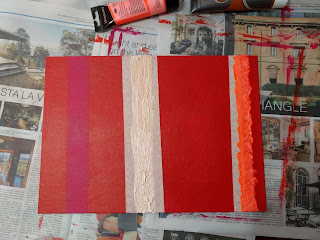Learning to paint like Barnett Newman (an Abstract Expressionist)
So who is Barnett Newman
Barnett Newman's paintings have sold for as much as 84,165,000USD, yet some critics have dismissed his work with comments suggesting that a "house painter" could achieve the same effect - large backgrounds of a single colour, punctuated by stripes of similar or contrasting colours - perplexing to the lay person, but clearly valued by collectors and the art establishment. So who was this man and what was his story?
Barnett Newman belonged to an inter-disciplinary group of artists who lived in New York between the 1930s and 1970s and came to be known as the New York School. They were known as Abstract Expressionists and included artists such as Jackson Pollock, Mark Rothko, Piet Mondrian and Willem de Kooning among others. Their aim was to create an art movement that usurped Paris and put New York firmly at the center of the art world.
Abstract Expressionism eventually set the stage for Pop Art and Minimalism.1
An institution which played a major role in facilitating the growth of the New York School, was the Metropolitan Museum of Art (MoMa) which incidentally offers a free on-line course on "Post War Abstract Painting" to anyone who wants to develop an understanding of the subject at https://www.coursera.org/learn/painting. The course is taught by Corey D'Augustine (an artist, curator and art historian) and is information-packed but easy to follow and fit into a busy schedule.
Abstract Expressionism
Abstract Expressionism is one of the range of art movements that arose after the invention of the camera, the others being - Impressionism, Expressionism, Cubism, Surrealism, etc. Each had its own rationale and techniques. Most are not intuitively accessible to a lay person who can identify with art that depicts something that is "real" or "natural".
After the invention of the camera (which produced more complete "real" or "true" images than any human artist could hope to achieve), artists were challenged to portray the world in different ways. Also, photography made art more portable, accessible and cheap. For example, photographs of people were far cheaper and easier to produce than painted portraits and as a result portraits ceased to be the privilege of the well-to-do and became democratised. Consequently, artists were challenged to look for ways in which to show that their work added meanings that photography could not compete with. In essence, photography allowed artists to create non-representational works. They no longer needed to record events and subjects, but to interpret them. This eventually evolved into a range of art movements. Abstract Expressionism was one such movement. Like all movements, it was of a place (New York) and time (post World War II until the late 1960s/early 1970s), but its legacy lives on.
Barnett Newman was perhaps the most cerebral of all the artists connected with the New York School.
Characteristics of Barnett Newman's work
Barnett Newman was born in New York in 1905 to Polish Jewish immigrant parents. He studied philosophy at the City College of New York and initially worked in his father's clothing business. He later became a teacher, writer and critic, all the while studying and experimenting with art. His early works were in the surrealist style but he was also influenced by Native American art.
(Onement 1 - 1948 - Barnett Newman - https://uploads0.wikiart.org/images/barnett-newman/onement-i-1948.jpg!Large.jpg)
On his birthday in 1948, he produced a small painting which showcased what came to be known as his "style". He began by staining the canvas with maroon oil paint. Once dry, he applied a strip of masking tape, over this ground and then tentatively painted a vertical line in orange oil on top of the masking tape. This small simple painting felt significant and he spent the next eight or nine months thinking about what it represented to him.2
He came to the conclusion that the stripe represented a streak of light. Stripes became a feature of his work and later came to be referred to as "zips". He said that he wanted his paintings to speak for themselves and viewed the painter as a "choreographer of space". He saw his work as a form of narrative art in which he eliminated objects and instead represented "forms of thought as expressions of the universal experience of being alive."
Some of his artworks have been described as blurring the lines between art and sculpture.
He explained why he did not include objects in his painting saying, " When you see a person, you have an immediate impact. You do not have to really start looking at details. Your first reaction when you meet a person for the first time, is immediate and It is a total reaction in which the entire personality of the person and your own personality make contact. To my mind, that is almost a metaphysical event. If you have to start examining the eyelashes and all that sort of thing, it becomes a cosmetic situation which you remove yourself from the experience." 3
How to produce a Barnett Newman-like painting (with three different types of zips)
The following is an adaptation of a lesson taught by Corey D'Augustine as part of the MoMA "Post War Abstract Painting" which I strongly recommend.
As I did not have the materials and paints recommended I used what I had at hand and was really pleased with both the results and what I learnt.
Materials I used:
- An artist canvas panel - acrylic primed for use with all mediums
- Masking tape
- Two brushes - one large and flat, one small and flat.
(Acrylic paint colours in order of application):
- Hot pink (the recommended colour was quinacridone magenta)
- Warm red
- A mix of gel medium, white, burnt sienna and gold glitter
- A mix of gel medium and fluorescent orange acrylic paint
Method:
1. Use the large flat brush to cover the entire canvas with three layers of hot pink - applied vertically, horizontally and vertically in the opposite direction. Let each layer dry before applying the next one. Let the canvas dry completely before attempting the next step.
2. Orient the canvas in landscape mode. Apply two overlapping strips of masking tape across one end of the canvas. 3. Apply three layers of warm red using the same technique used in step 1. Once dry, remove the masking tape to reveal Zip1.For Zips 2 and 3:
4. (a) Apply two layers of masking tape (with a 2.5 cm gap between them) just off-centre on the painted canvas.
4. (b) Apply one layer of masking tape 5cm away from the extreme right of the canvas
4. (c) Mix 2 parts each of white paint and gel medium with 1 part each of burnt sienna, gold glitter. Apply to the central gap between the two masking tape strips (see photo)
4 (d) Mix equal parts of gel medium and fluorescent orange acrylic paint
4(e) Apply to the right of the masking tape on the extreme right of the canvas. Scumble the paint with the smaller brush
Let the paint dry completely
5. Remove the masking tape to reveal three zips
You now have an abstract expressionist painting in the style of Barnett Newman.
________________________________________________________________
2 https://www.youtube.com/watch?v=e2c0h1wnxf0
3Ibid.








Comments
Post a Comment